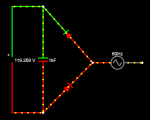svetz
Works in theory! Practice? That's something else
This is for all you EE geeks (yeah phogandive , that includes you buddy!)
Now DC makes perfect sense to me, you put an electron on it bumps electrons all along the way until one at the end of the circuit falls off; it needs a return wire for that electron to make it back.
But AC is a frequency. Put on a few electrons, then pull a few off.
The typical household 120 AC as measured by the RMS method. But that pretty sine wave behind is running 340 volts peak to peak behind it.
Since it's put some on and pull some off, why do you need the wire for the return trip? If I had a pair of diodes, like the front of an H bridge, then when some electrons were put on it could take one path and push electrons into the circuit. When it pulls some off if could pull from the other diode pulling excess electrons out of the circuit.
I'm not saying two wires wouldn't be more efficient, having two allows for no net capacitance at any time.
Think of it like using tidal energy; you're using the imbalance in voltage over time to accumulate charge rather than a return path for electrons to flow. It's not done now to my knowledge, but I don't see why it wouldn't work since once you have charge it would be like a DC battery. As mentioned earlier, it wouldn't be efficient - but I don't see why it wouldn't work. Here's a circuit diagram that's at least fooled the simulator into thinking it would work...
Now DC makes perfect sense to me, you put an electron on it bumps electrons all along the way until one at the end of the circuit falls off; it needs a return wire for that electron to make it back.
But AC is a frequency. Put on a few electrons, then pull a few off.
The typical household 120 AC as measured by the RMS method. But that pretty sine wave behind is running 340 volts peak to peak behind it.
Since it's put some on and pull some off, why do you need the wire for the return trip? If I had a pair of diodes, like the front of an H bridge, then when some electrons were put on it could take one path and push electrons into the circuit. When it pulls some off if could pull from the other diode pulling excess electrons out of the circuit.
I'm not saying two wires wouldn't be more efficient, having two allows for no net capacitance at any time.
Think of it like using tidal energy; you're using the imbalance in voltage over time to accumulate charge rather than a return path for electrons to flow. It's not done now to my knowledge, but I don't see why it wouldn't work since once you have charge it would be like a DC battery. As mentioned earlier, it wouldn't be efficient - but I don't see why it wouldn't work. Here's a circuit diagram that's at least fooled the simulator into thinking it would work...




